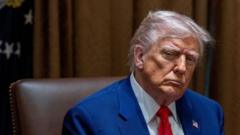Last week, President Trump unveiled an ambitious tariff plan aimed at reshaping the global economy and reinforcing America's trade position. However, recent developments have seen him suspend increases on tariffs for 90 days, particularly while engaging in a fierce trade conflict with China. This move raises the pivotal question of whether Trump is any closer to achieving his five key tariff goals.
1) Better Trade Deals:
Trump has long asserted that nations have exploited the U.S. marketplace. Following his tariff announcement, he initiated discussions with countries worldwide, claiming that more than 75 world leaders sought agreements with him. Although official negotiations with nations like South Korea and Japan are underway, the efficacy of these discussions remains uncertain, as time is of the essence.
2) Boosting American Industry:
Trump has consistently argued that tariffs protect U.S. manufacturing. However, the unpredictable application of tariffs creates an unstable environment for companies considering "reshoring." Business leaders often delay significant investments due to the lack of regulatory clarity, possibly stalling Trump’s vision of revitalizing American factories.
3) Confronting China:
Originally positioning China as the prime antagonist in U.S. trade issues, Trump's approach seems tentative following an apparent shift in tone. Despite insisting that past U.S. administrations are to blame for trade imbalances, he faces challenges as tensions rise with this economic powerhouse, complicating the potential for allies to support his stance.
4) Raising Revenue:
Trump's optimism over tariff revenues has been met with skepticism. Analysts previously estimated a universal 10% tariff could yield significant income. While staying the course might provide the anticipated revenue for tax cuts and programs, any switch to domestic production could reshape expectations about this income stream.
5) Lowering Prices for U.S. Consumers:
While Trump hopes tariffs will lead to lower costs through increased domestic production, economists warn that such measures could have the opposite effect. Tariffs typically push up consumer prices, disproportionately impacting lower-income households. If accurate, this could undermine Trump's economic promises and political stability.
As time elapses and negotiations unfold, the real impact of Trump’s tariff strategy on the U.S. economy remains to be seen, along with its broader implications for international trade relations.




















